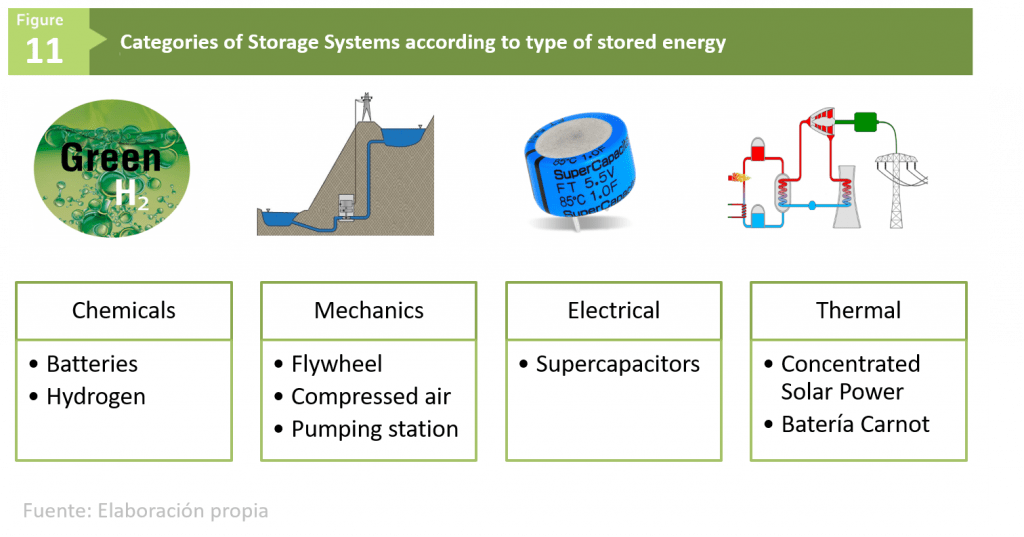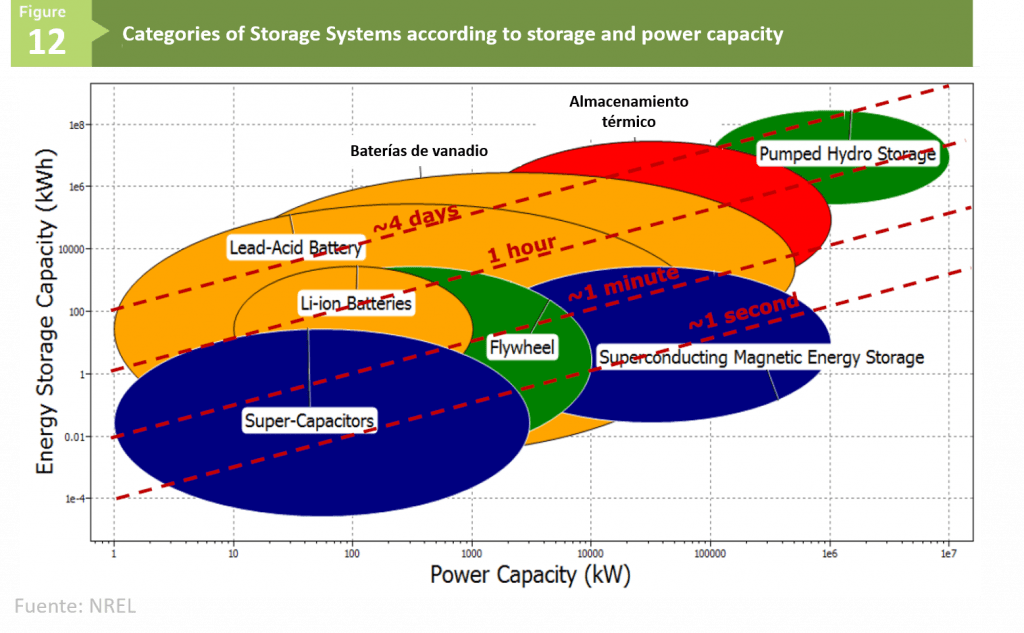2.5. Storage Systems
The Law 20,936 of 2016 added for the first time in Chilean legislation aspects related to energy storage, including Energy Storage Systems to the list of coordinated by the SEN. The definition presented regarding storage systems is as follows:
“Technological equipment capable of withdrawing energy from the electric system, transforming it into another type of energy (chemical, potential, thermal, among others) and storing it with the objective of, by an inverse transformation, injecting it back into the electrical system, contributing to safety, sufficiency or economic efficiency of the system”.
It should be mentioned that the regulation of the coordination and operation of the national electric system is in elaboration, in which the provisions to integrate the storage systems in the programming and operation of the system are established. Specifically, it establishes the obligations of the Coordinator to operate the withdrawals and energy injections of these systems, and defines its participation in the system of arbitration of energy prices. Also, it establishes the methodology to consider these systems within the operation programming, as well as how to determine the variable costs and the recovery window of the storage system.
In general, storage systems are categorized by the type of energy they store, such as: electrochemical, mechanical, electrical and thermal. Figure 11 shows the main types of energy and storage technologies.
 Another way of characterizing the different storage technologies is by their energy and power storage capacity. In this way, technologies that are capable of storing large amounts of energy and with a high energy injection such as Carnot batteries[22] are differentiated from smaller technologies with less storage capacity such as lithium batteries. Figure 12 shows the types of technology distributed according to storage capacity and power. The red lines refer to the typical regulatory capacity of these technologies. That is, how long can they maintain the maximum power injection using previously stored energy.
Another way of characterizing the different storage technologies is by their energy and power storage capacity. In this way, technologies that are capable of storing large amounts of energy and with a high energy injection such as Carnot batteries[22] are differentiated from smaller technologies with less storage capacity such as lithium batteries. Figure 12 shows the types of technology distributed according to storage capacity and power. The red lines refer to the typical regulatory capacity of these technologies. That is, how long can they maintain the maximum power injection using previously stored energy.
 Regulation S.D. N°125 of 2019 of the Coordination and Operation of the SEN establishes the provisions to integrate storage systems and centrals with pumped storage in the programming and operation of the system. This regulation allows storage systems to be used for the provision of ancillary services, price arbitration or incorporation as infrastructure associated with transmission systems.
Regulation S.D. N°125 of 2019 of the Coordination and Operation of the SEN establishes the provisions to integrate storage systems and centrals with pumped storage in the programming and operation of the system. This regulation allows storage systems to be used for the provision of ancillary services, price arbitration or incorporation as infrastructure associated with transmission systems.
The two modes of operation of these systems are withdrawal and injection:
- In withdrawal mode, the electrical energy withdrawn from the electrical system is transformed into another type of energy for storage.
- In injection mode, previously stored energy, coming from energy withdrawals for storage, is transformed into electrical energy for injection into the electrical system.
With regard to withdrawals, the Coordinator and the storage system operator must propose withdrawal programs, the Coordinator’s will be considered efficient while the other will determine the definitive withdrawal program. In actual operation, hours that do not contribute to the economic and safe operation of the system will be classified as those hours in which the respective installation has implied a higher level of hourly power withdrawal than that defined in the designated efficient program for said hour.
Law 20,936 establishes that withdrawals made in the storage process will not be subject to the charges associated with end customers, nor to the obligation to prove that at least a percentage of these come from renewable sources.
Regarding the injection mode, the Coordinator must choose one of the following methodologies:
- Consider injection in the priority list with a variable cost determined by the Coordinator; or
- Determine the placement of the stored energy in storage, or in a certain time horizon, minimizing the total cost of operation and failure, and preserving the safety of the system. The cost assigned to the stored energy must not be less than the variable cost referred to in the previous point.
The variable cost will be equal to the quotient between the recovery of energy withdrawn from the electrical system, for the storage process during the recovery window, to the marginal cost of the respective withdrawal bar, and the energy withdrawn for storage in the same period, adjusted by a factor that reflects all the energy losses incurred in the energy withdrawal, storage and injection processes.
The withdrawals and injections of energy made for price arbitration will be valued at the marginal cost of the corresponding bar, in this way the storage systems participate in the energy balance.
Regarding the ancillary services market, Law 20,936 is technologically neutral. Therefore, any facility that meets the standards required for the provision of each type of service is a possible provider. Currently there are storage systems enabled to provide primary frequency control to the SEN.
As for the contract market, storage systems are allowed to support bidding in energy tenders for regulated customers. This was for the first time allowed in the bases of the energy tender dated May 2021 (which was postponed but not carried out). The purpose of this tender is to auction 2,310 GWh to supply the energy needs of the regulated clients of the SEN starting in 2026 for 15 years.
However, with respect to the trading of energy with distributors or free clients, the storage systems may not make withdrawals of energy to trade with them.
On the other hand, D.S. N°37 of 2021 presents general guidelines to include storage systems in the planning of the transmission system. This establishes that storage systems may be incorporated that allow to increase the safe transmission capacity or supply the demand of end customers where, it is verified that a solution through conventional transmission infrastructure alternatives is not adequate, either due to economic efficiency or chance.
For the purposes of the above, only those that have the following characteristics and purposes may form part of the project portfolios of the different stages of transmission planning:
- Power-intensive energy storage systems: those whose purpose is to increase the safe transmission capacity and whose quotient between their energy storage capacity and their nominal power is less than or equal to 0.5.
- Energy-intensive energy storage systems: those whose purpose is to allow the supply of the demand of a specific area, belonging to one of the Zonal Transmission Systems, and whose quotient between its energy storage capacity and its nominal power is less than or equal to 5.
The storage systems may provide other services that are compatible with the transmission service required in the expansion plan. For this, the owner can build it with higher levels of power and energy assuming its cost. The operation that is made of the proportion not awarded must at all times, allow the provision of the transmission services required in the expansion plan. The design of the system awarded must be such that its operation does not impose restrictions on the transmission system that requires additional investments.
Regarding renewable power plants with storage capacity, the S.D. N°125 of 2019 defines how these technologies should be integrated into the coordination of the operation. The definition presented is the following:
“Renewable generation plant that uses variable primary resources, composed of a generation component and a storage component, both with the same connection point to the electrical system. The generation component corresponds to the technological equipment to transform primary energy into electrical energy, while the storage component is that equipment capable of transforming the electrical energy produced by the generation component into another type of energy and storing it with the aim of, by means of an inverse transformation, to inject it into the electrical system”.
Unlike storage systems, these plants should not make withdrawals from the system to store energy, since the storage process will be carried out exclusively with energy inputs from their own generation. Unless for security reasons the Coordinator instructs such action. Another great contrast is that they can trade energy with free customers or distributors. This action is not possible for non-self-generated storage system owners.
On the other hand, the temporary energy management capacity of renewable power plants with storage capacity is recognized in the remuneration of the capacity market. Therefore, a renewable plant can increase its recognition of contribution to the sufficiency of the system by adding a storage system to its generating plant.










